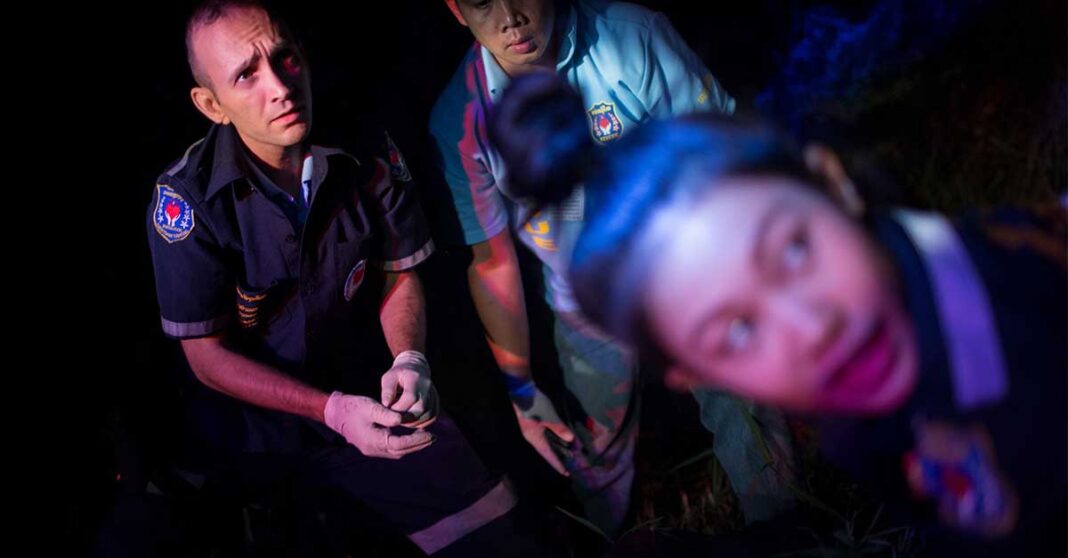Founder of Vientiane’s volunteer emergency service, Sebastien Perret, discusses Vientiane Rescue’s operations amid the continued problem of road accidents.
Sebastien Perret, Co-Founder of Vientiane Rescue, had not been in Laos long before he witnessed a gruesome traffic accident. Police officers were dispatched to the scene but no medical assistance was provided, meaning life-saving emergency care was not available to accident victims. This terrible tragedy gave him the idea of starting a volunteer emergency rescue service that could provide immediate medical aid to road accident victims.
“When we started a lot of people cautioned me about the burden of the responsibility as we did not have regulations or legal framework in place for doing rescues. During the first two years of the operation, the Vientiane Rescue continued to operate without much hope for the future or medical aid for training our personnel,” he said.
Vientiane Rescue started off with just seven volunteers, including two drivers, in 2010. Despite the lack of equipment and personnel, the rescue team continued to assist those who were injured in road accidents.
But volunteers were quick to sign up, and in the following years, the rescue service grew to a strength of more than 500 volunteers stationed across Xieng Khouang, Pakse, and Vientiane Capital.
The outbreak of the Covid-19 pandemic, however, changed everything. With fuel prices skyrocketing amid rampant inflation, volunteers began dropping out and new expenses caused major setbacks for the rescue service.
“Covid-19 almost killed us. We needed to transfer Covid-19 patients safely without having the access to vaccinate some volunteers. As a result of working nonstop for 24 hours, the volunteers also experienced mental and physical breakdowns,” he said.
Nevertheless, a core team of 300 volunteers remains in active service, with 45% of these being female.
Vientiane Rescue urges the public to recognize the efforts of their volunteers in Laos in the hope of expanding and delivering better life-saving emergency services.
“Today, we’re just fixing the problems little by little. Volunteers in one of our stations are quite overworked and tired. We need to plan a sustainable future by starting a training center and expanding to provide emergency services in more provinces,” said Sebastien.

Laos recorded its highest number of road accidents in Vientiane Capital in 2022, with the majority of accidents caused by speeding, while accidents killed over 900 people nationwide in the same year.
However, authorities agree that the actual numbers are likely to be much higher.
“Most people involved in accidents do not want to call the police out of fear of legal repercussions. As a result, we don’t receive accurate figures on the number of accidents that have occurred,” said Sebastien.
Speeding is cited as the primary cause of accidents in official reports after many traffic accidents in Vientiane, but driving under the influence of alcohol significantly increases the danger of such incidents.
“When people get behind the wheel or ride under the influence of illegal substances, they are oblivious to the danger they are putting themselves and other people in,” he says.
According to Sebastien, 30% of people involved in traffic accidents are men who are riding motorcycles and crashing on their own. Many motorcyclists don’t wear helmets, while passengers in cars fail to fasten their seatbelts. Even when helmets are worn, these are often of poor quality, leaving riders’ faces and chins exposed.
“I saw a man hit a car that was parked by the side of the road. Although he was wearing a helmet, it was removed by the rescue team and revealed a bloody face. However, wearing a helmet of not great quality is better than wearing nothing,” Sebastien says.
He points out that poor road conditions and motorists’ general attitude on the road contribute to accidents as well.
“Motorists should think about the consequences more since they are not the only ones on the road. Others are going home to meet their families and loved ones,” he pleads.
While road safety awareness campaigns may lack efficacy in some ways, much can be done to help promote a culture of safety by valuing the lives of other drivers and pedestrians in Laos.
At the same time, the underequipped but highly efficient volunteers of Vientiane Rescue operations need recognition and funding to continue their life-saving operations on the often dangerous city streets.
“When we have attended conferences on emergency operations, our operation in Laos made the people of other nations proud. I hope people in our own nation still appreciate the job we do,” Sebastien adds.



